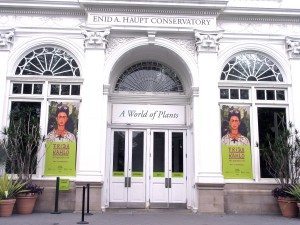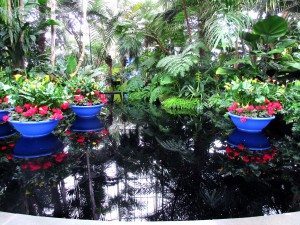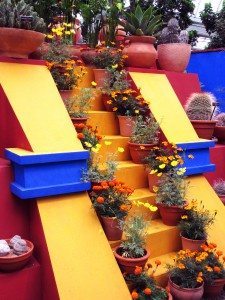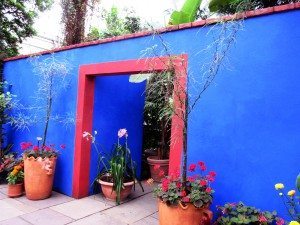
New York Botanical Garden exhibit dazzles
By Lyn Dobrin
Step into the rotunda entrance of the Conservatory at the New York Botanical Gardens and you are immediately introduced to the vivid world of artist Frida Kahlo. Three large indigo blue bowls filled with colorful tropical flowers seem to float in a glassy pond.
That brilliant blue will be repeated throughout the displays at “Frida Kahlo: Art, Garden, Life,” a stunning exhibit running until the Mexican Día de los Muertos (Day of the Dead), on Nov. 1. That blue is the color that Kahlo used throughout La Casa Azul (The Blue House), her childhood home outside Mexico City and where she also lived for 25 years with her husband, muralist Diego Rivera. The house is now a museum and here in New York visitors are able to appreciate Kahlo’s work that extended through her art into the flora, fauna and culture of Mexico.

Born to a Mexican mother and German father, the artist was both an original and a traditionalist who lived life at full throttle. Such was Kahlo’s commitment to Mexico that, although she was born in 1907, she gave her birth year as 1919, the start of the Mexican Revolution.
“Many of her works engage with the themes of her own mixed heritage as well as the indigenous and Spanish roots of modern Mexican culture,” says Joanna Groarke, a curator at the NYBG.

The centerpiece of the garden exhibit is a replica of Diego Rivera’s four-tiered pyramid—mimicking pyramids found throughout central Mexico—that displayed his collection of pre-Hispanic artifacts. Here are a variety of cacti in terra-cotta pots and flowers in bloom, most particularly marigolds, which play a chief role in Mexico. Signage through the gardens, in both English and Spanish in this bilingual exhibition, tells the significance of each plant and why it would have found its way into Kahlo’s garden. Marigolds, a native Mexican plant that has been cultivated since the pre-Hispanic era, are displayed in abundance throughout. In an alcove near the pyramid is a recreation of Kahlo’s workspace from her art studio.
“The garden was a creative refuge for Frida and her studio overlooked the garden,” said Bilingual Interpretive Specialist Claudia Mora.
The gardens are enough to feed the soul but think about spending the day. “Frida Kahlo: Art, Garden, Life” offers a total Frida/Mexico immersion with art, poetry, live music, film, food and activities for adults and children.
Here is some of what’s going on:
• At the garden’s library are 14 of Kahlo’s paintings and works on paper—many borrowed from private collections—highlighting the artist’s use of botanical imagery. Her best known work, the mesmerizing “Self-Portrait with Thorn Necklace and Hummingbird,” is there. Also on view are large-scale photographs of Kahlo and the Casa Azul’s garden, which are complemented by photographs of Kahlo taken by photographers and friends.
• Contemporary artist Humberto Spindola has recreated the dresses in “The Two Fridas” on life-size mannequins. The dresses are made of tissue paper using a Mexican folk art technique with roots in the 17th and 18th centuries.
• At the children’s garden there is a self-portrait station, a “Frida and Her Pets” puppet theater, planting and cooking activities.
• In the permanent exhibition house of the Conservatory, visitors can take the self-guided Mexican Plant Tour, which showcases the many plants native to, grown in and culturally important to Mexico within NYBG’s permanent collections.
• Poems of the Nobel laureate Octavio Paz, a fellow countryman of Kahlo, that make reference to nature are displayed on posters adjacent to the conservatory. The poems are in English and Spanish.

It’s not necessary to leave the garden for interesting food. Try the food truck with tacos and churros and other Mexican treats. During the week it is located at the bottom of Tulip Tree Allee; on weekends it moves to other parts of the garden.
For more information, visit www.nybg.org for a schedule of activities. If you come during the last two weeks before the show closes on Nov. 1 you will be able to experience Día de los Muertos events and on the last weekend, a special altar for Frida on the pyramid. Expect to see lots of marigolds, as it is believed that marigolds guide the spirits of the dead to their altars using their vibrant color and scent.


















